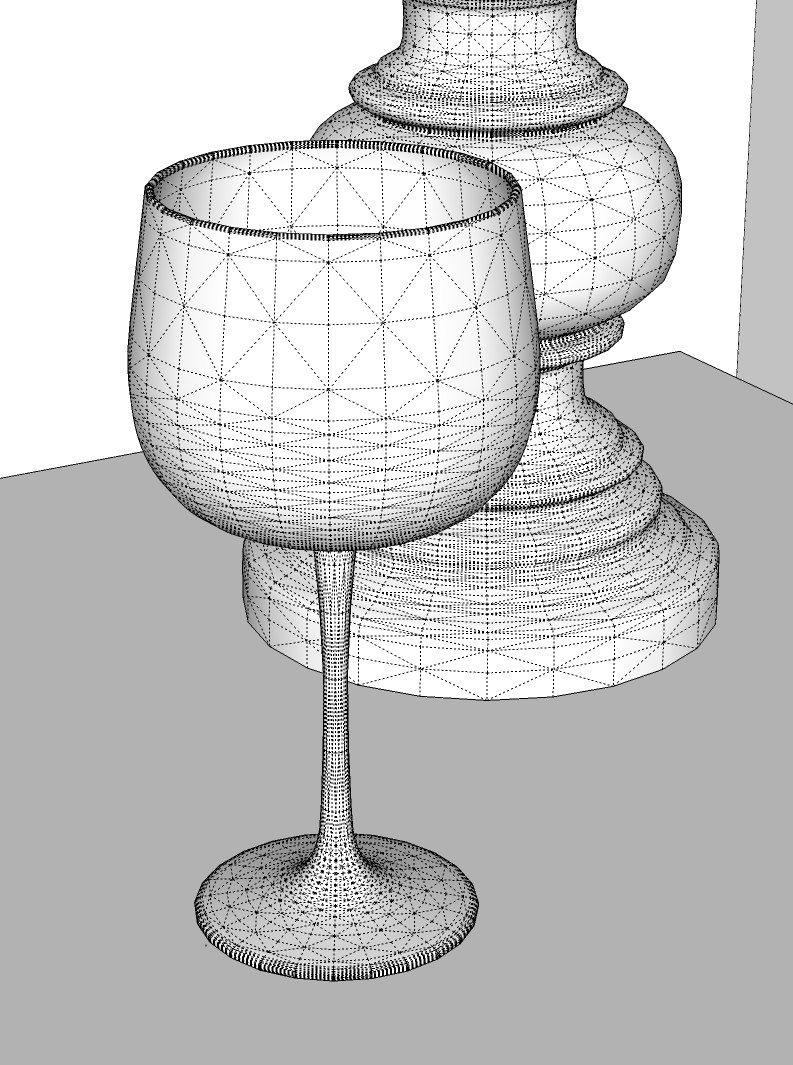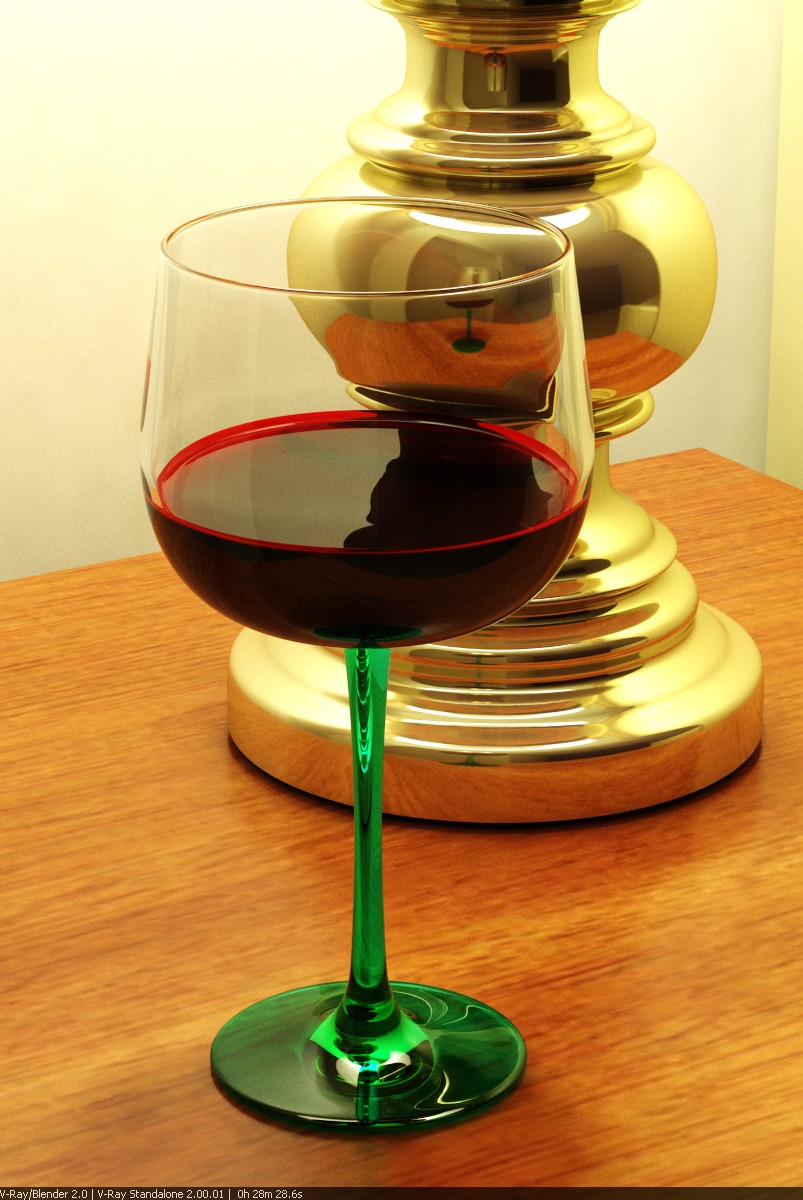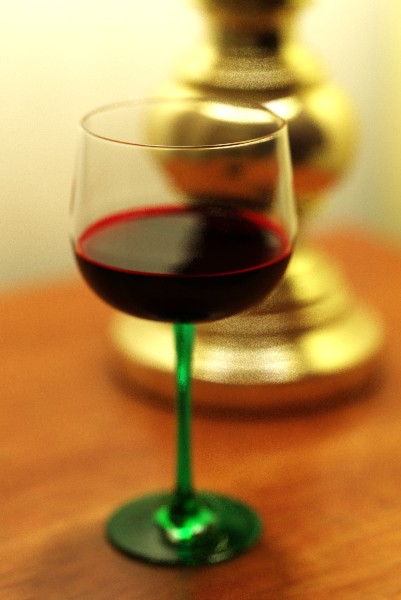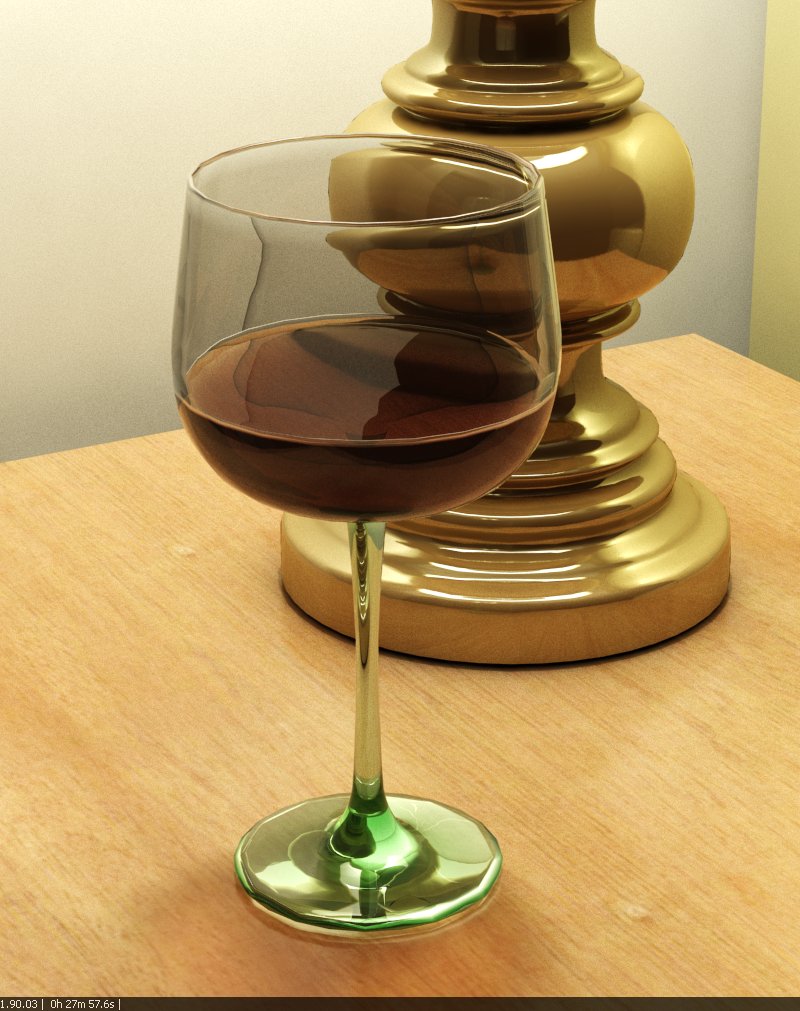Vray for blender
-
So I thought I would post a relatively simple 1 to 1 comparison of a scene in Sketchup and the same scene in Blender, both rendered with vray (different versions - the SU version is a year or so behind...) Here is the wireframe in SU. I exported as a 3ds mesh into blender. The camera views aren't exact matches, but oh well.

Here is the original photo I based the model on.
Next, I adjusted the materials as best I could in vfsu, set the lighting to real-world units (the bulb in the lamp is 1200 lumens)

Then, I did the same in Blender - except that I used a smooth and a subdivision modifier on the wineglass and the lamp to get the curves nice and clean. The lighting is the same, using the same exposure and light source. The material properties, even though I tried to match, the fog effect seems to be completely different in v/b - much closer to the photo. The colors, even with the same color mapping, etc, are quite different, and seem much more accurate.

-
Pete- sure why not. Have fun! It's all modeled from scratch, so no reason not to share.
-
@tomDC - yeah, I'm going to learn more about bmesh when I have a chance, looks really powerful. Right now the v/b build is with 2.62
-
Yeah ... bmesh looks good. Its bevel tool still needs some work, though.
-
well, vray has a round edges. That's one thing I want to play with sometime.
-
quick DOF test.

-
Thanks Anybot
This is very exciting. Ive started to watch some video tutorials. Seem all very compatible to what we know in Vray4SU.
Have you already purchased the standalone or are you still using the demo versions. -
Hey Jonathan - I did buy the license. Once I installed the vray for blender build and saw how good the integration is with vray, I knew right away it would be worth the purchase. I had been trying other blender rendering add-ons earlier - luxrender, thea, yafaray, cycles, but none of them were doing it for me. Also, I never did get indigo to work, nor renderman. Anyway, with vray, there's just no comparison.
-
i'm especially surprised by the looks of the rounded edges... but i guess that's a SketchUp thing, rather than VRay's, right?
-
@eidam655 said:
i'm especially surprised by the looks of the rounded edges... but i guess that's a SketchUp thing, rather than VRay's, right?
Well, now that I play with it more, that's actually mostly a subdivision issue. Here is the same vfsu scene with 2 iterations of SDS instead of one.

-
I suppose blender/vray will really come into its own when dealing with heavy scenes. Have you played with proxies/instancing yet, or a textured model that would normally given you a hundred bug splats?
-
I'm working on a big scene as I have time. I'm finding it's quite a bit of cleanup to export something with a lot of components.
-
i suppose you will start collecting high poly better models to use anyway. Oh bring on evermotion models Yummmmmmmmmm
-
I've scratched the surface of blender to and the possibilities are good in my opinion. The only thing i havent figured oput yet is the best format to export to Blender. I don't want to spend a lot of time organising the model hierarchy in Blender. Love some pointer on the export to blender workflow.
Greetz Twan
-
@pugz1983 said:
The only thing i havent figured oput yet is the best format to export to Blender. I don't want to spend a lot of time organising the model hierarchy in Blender. Love some pointer on the export to blender workflow.
Hi Twan,
I'm still trying to figure out the best methodology too. So far, the two options that have worked are using SU pro native 3ds exporter, and using TIG's object exporter
My wineglass and lamp was brought in using the 3ds export. The group and component heirarchies are kept, and the shapes came in properly as meshes. I added smoothing and subdivisions, adjusted the materials to it to the render.
The objexporter gets rid of the heirarchies and groups things by material. This is useful when there are lots of small groups and components that can make it hard to navigate the model. It's also helpful because you can easily replace material since there's one mesh per material (there may be a global way to replace, I just haven't figured it out yet.) The big issue I've run into is that duplicate vertices are exported, but that has a relatively easy fix thanks to michalis' tip
There are still more parts of the workflow I am testing as I have time, but hope this gets you in the right direction.
-Andy
-
Thanx for the tips Andy. I'll give it a go when I get back from work today. After looking at the trailer of the Nature Academy Tutorials I really started to get interested in Blender. Do you use Blendup to make the controls more like in SU?
Greetz Twan
-
I'm surprised 3ds worked better than the collada format (*.dae), I thought that was supposed to be the end all be all format these days.
-
@dkendig said:
I'm surprised 3ds worked better than the collada format (*.dae), I thought that was supposed to be the end all be all format these days.
Collada just doesn't seem to be that well supported. It seems like it breaks regularly with Blender updates.
@pugs1983 - I'm fine with the blender interface as it is v2.5 and higher. It's the rotate, zoom, pan that's been "fixed" from earlier versions that makes it easy to use.
Advertisement







